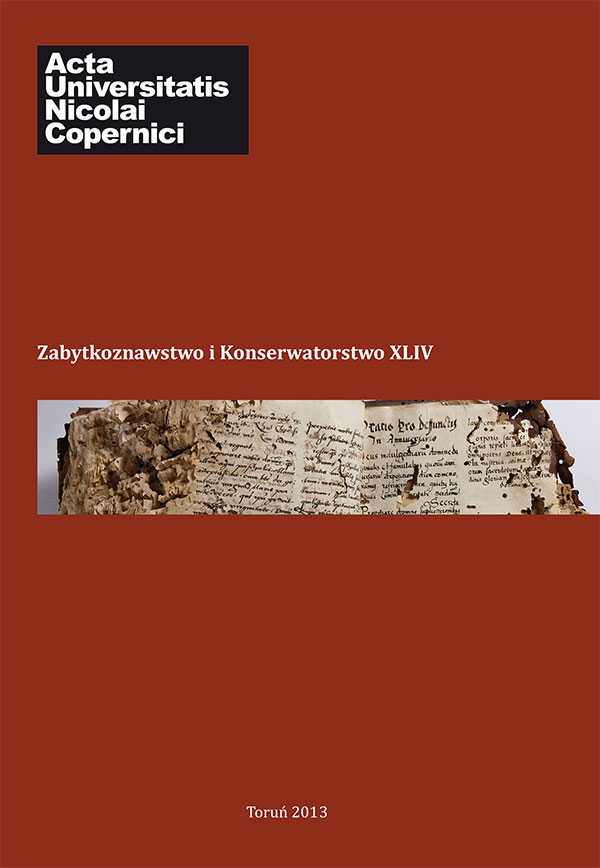Dialog z tradycją w konserwatorstwie – koncepcja zabytkoznawczej analizy wartościującej
DOI:
https://doi.org/10.12775/AUNC_ZiK.2013.021Abstrakt
Valuation in conservation of cultural heritage has became a subject for scientific reflection thanks to Alois Riegl, who in his Der Moderne Denkmalkultus from 1903 identified and described motivations and values linked to the works on monuments of the past. His systematic of values has been found useful not only in deciding on whether a given object should be protected by law, but also for planning the conservation-restauration processes. One of the greatest continuators of Riegl’s thought was Walter Frodl (1908–1994), who suggested updating the systematics which dated back to the beginning of the 20th century.
The reasoning in this article is based on the comparison of both theories, with special attention paid to the order the values described in the systematics and to different ways of understanding them. The analyses presented here lead to the idea that in the dialogue between Frodl and Der Moderne Denkmalkultus, the key concept is the abandonment of the division between Memory Values (Erinnerungswerte) and Present-Day Values (Gegenwartswerte). It is not the issue of conservation of lieux de mémoire that is the most important in Frodl’s thought. As opposed to Riegl, he does not seek the cultural sources of different approaches to conservation and he does not explain the origins of the modern monuments conservation. Instead, he focuses on the objects that are already protected by conservators, and which are subject to the actions taken by the administration. By abandoning the direct commentary on the issues of collective memory, he tries to enrich the axiological frame of reference with the values that originated in the relationship between monuments and their spatial and social contexts.
The results of such a multilevel comparative analysis has been used to develop an updated version of the systematics of values for architectural conservation. A framework for the model for the value evaluation of monuments that is used in practical conservation process, as well as in the education of future conservators at Nicolaus Copernicus University in Toruń, and different stages of such evaluation, are presented in the conclusions of this article.
Pobrania
Opublikowane
Jak cytować
Numer
Dział
Licencja
CC BY-ND 4.0. Posiadaczem prawa autorskiego (Licencjodawcą) jest Autor, który na mocy umowy licencyjnej udziela nieodpłatnie prawa do eksploatacji dzieła na polach wskazanych w umowie.
- Licencjodawca udziela Licencjobiorcy licencji niewyłącznej na korzystanie z Utworu/przedmiotu prawa pokrewnego w następujących polach eksploatacji: a) utrwalanie Utworu/przedmiotu prawa pokrewnego; b) reprodukowanie (zwielokrotnienie) Utworu/przedmiotu prawa pokrewnego drukiem i techniką cyfrową (e-book, audiobook); c) wprowadzania do obrotu egzemplarzy zwielokrotnionego Utworu/przedmiotu prawa pokrewnego; d) wprowadzenie Utworu/przedmiotu prawa pokrewnego do pamięci komputera; e) rozpowszechnianie utworu w wersji elektronicznej w formule open access na licencji Creative Commons (CC BY-ND 4.0) poprzez platformę cyfrową Wydawnictwa Naukowego UMK oraz repozytorium UMK.
- Korzystanie przez Licencjobiorcę z utrwalonego Utworu ww. polach nie jest ograniczone czasowo ilościowo i terytorialnie.
- Licencjodawca udziela Licencjobiorcy licencji do Utworu/przedmiotu prawa pokrewnego nieodpłatnie na czas nieokreślony
PEŁEN TEKST UMOWY LICENCYJNEJ >>
Statystyki
Liczba wyświetleń i pobrań: 1839
Liczba cytowań: 0



